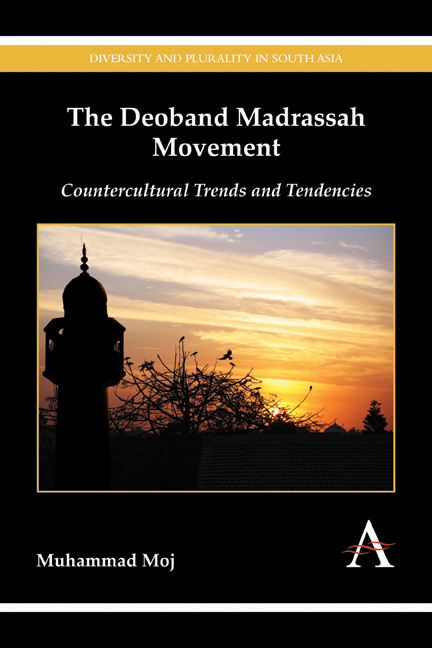Book contents
- Frontmatter
- Dedication
- Contents
- Preface
- Prologue
- Chapter 1 The Deoband Madrassah Movement: Research Context
- Chapter 2 Origin of the DMM: Seeds of a Counterculture
- Chapter 3 The DMM in United India: Activist Countercultural Trends
- Chapter 4 The DMM in Pakistan: Countercultural Politics and Extremism
- Chapter 5 Deobandi Islam: Countering Folk Islam and Popular Custom
- Chapter 6 The DMM versus Mainstream Society: Viewpoints of Deobandi Journals and Students
- Epilogue
- Appendix I The Deobandi Stance vis-à-vis Muslim Groups other than the Barelwis
- Appendix II Countercultural Exposition of the Deobandi Taliban
- Appendix III Interview Guide
- Glossary of Islamic Terms
- References
- Index
Chapter 2 - Origin of the DMM: Seeds of a Counterculture
Published online by Cambridge University Press: 05 December 2015
- Frontmatter
- Dedication
- Contents
- Preface
- Prologue
- Chapter 1 The Deoband Madrassah Movement: Research Context
- Chapter 2 Origin of the DMM: Seeds of a Counterculture
- Chapter 3 The DMM in United India: Activist Countercultural Trends
- Chapter 4 The DMM in Pakistan: Countercultural Politics and Extremism
- Chapter 5 Deobandi Islam: Countering Folk Islam and Popular Custom
- Chapter 6 The DMM versus Mainstream Society: Viewpoints of Deobandi Journals and Students
- Epilogue
- Appendix I The Deobandi Stance vis-à-vis Muslim Groups other than the Barelwis
- Appendix II Countercultural Exposition of the Deobandi Taliban
- Appendix III Interview Guide
- Glossary of Islamic Terms
- References
- Index
Summary
A new cultural pattern does not emerge out of nothing – the seed must already be there.
Philip Slater, The Pursuit of Loneliness (1971, 111)This chapter establishes the case that the DMM continued what Shah Waliullah began. It also explains that some countercultural currents were present in his movement, but these were overshadowed by its larger intellectual canvas. Those countercultural trends gradually became more prominent after Waliullah's death, when a ‘practical’ rather than intellectual tradition became dominant. This chapter argues that the DMM was the continuation of the ‘practical’ version of Waliullah's movement. Finally, the chapter suggests that the DMM's intellectual decline brought forward the countercultural countenance of the movement, which came into conflict with several social and cultural norms and values of mainstream Muslim society in India.
Shah Waliullah's Movement
Shah Waliullah (1703–63) was born in Delhi four years before the death of the Mughal emperor Aurangzeb, whose death is considered to mark the beginning of the end of Muslim rule in India. In the fifty years following Aurangzeb's death, the Delhi court saw ten emperors, only four of whom died a natural death (Mian 1988, 76). As the palace intrigues weakened the central authority of the Mughal Empire, many regional power centres sprang up in India. Marathas took control of South India and later also gained influence in the Delhi court after their victory against the Mughals in 1736 (Mian 1988, 86). Rohailas set up their government north-east of Delhi, while Sikhs became strong in North West India (Abbott 1962). In 1737, Afghan ruler Nadir Shah attacked and looted Delhi, killing thousands of people. After that attack, North West India and Punjab were completely cut off from the Delhi sultanate. On the eastern front, Bengal, Bihar and Orissa also severed ties with the central government of Delhi. These regions were later occupied by the British East India Company after the Plassi war in 1757 (Mian 1957, vol. 2, 36–7).
- Type
- Chapter
- Information
- The Deoband Madrassah MovementCountercultural Trends and Tendencies, pp. 29 - 60Publisher: Anthem PressPrint publication year: 2015



